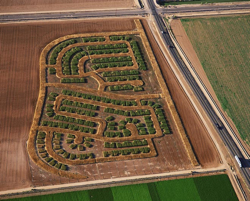Then head on over to Nigeria’s Daily Sun, where an interview with a retired director of the Nigeria Deposit Insurance Corporation makes is sound like an ideal life for the farmer seeking to diversify. He does consultancy too, which could make getting into that line of work easier.
Diversity and Art
 It’s a good weekend for unconsidered and diverse ramblings. Take the latest news to arrive on sorghum: an artist called Matthew Moore used sorghum and black-bearded wheat to create a scale-replica of a housing estate being built on land sold by his family. The houses are sorghum, the roads wheat. And the wheat wasn’t wasted. A local farmer so liked the piece that he harvested it for free. Details of the project, and Moore’s other work, here.
It’s a good weekend for unconsidered and diverse ramblings. Take the latest news to arrive on sorghum: an artist called Matthew Moore used sorghum and black-bearded wheat to create a scale-replica of a housing estate being built on land sold by his family. The houses are sorghum, the roads wheat. And the wheat wasn’t wasted. A local farmer so liked the piece that he harvested it for free. Details of the project, and Moore’s other work, here.
Photo by Matthew Moore, from WFMU.
Diversity and deep thoughts
We don’t normally go in much for philosophizing here, because by and large that’s something that I, at any rate, feel is best left to those with the time and inclination to think deep thoughts. However, there’s an interesting little spat brewing over in the further reaches of the blogosphere at Y Safle (which labels itself “pretentious waffle from Wales”). At issue is whether environmentalism and international development work against each other. One of the commenters seems to have got hold of completely the wrong end of the stick. I won’t attempt to summarize the arguments, which seem to hinge on exactly how one lets market forces operate, but if you’ve a moment or two, why not take a look?
Climate change and wine
Over at CABI’s blog there’s a great post summarizing some recent research on the possible effects of climate change on the wine industry. The grapevine is very sensitive to temperature and rainfall, making it a useful indicator of environmental change. Predictably, there will be both winners and losers among the traditional wine growing areas. Not quite sure how the average consumer will come out of it, but wine bores will have a whole new area of expertise to get to grips with.
Late blight origins
Ask anyone working in plant genetic resources for an example of the importance of growing genetically diverse crops and chances are that sooner or later they’ll mention the Irish potato famine, caused by the late blight fungus Phytophtora infestans in the 1840s. But for such an important – and iconic – disease, it is amazing how what we think we know about it keeps changing. There’s been a re-think recently about which strain of the fungus actually caused the outbreak in Ireland. And now there’s DNA work to figure out where the pathogen came from. The debate on that point seems now to have been decided in favour of the Andes.